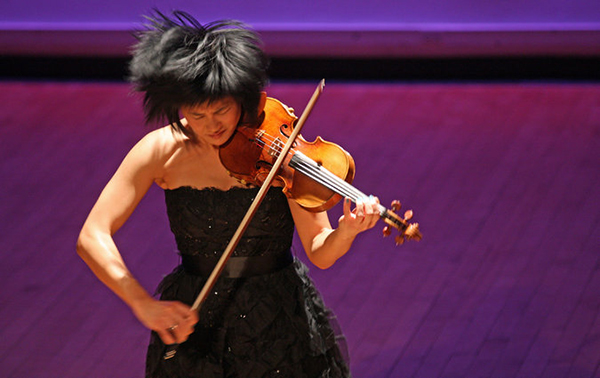The New York Times
By Vivien Schweitzer
January 07, 2014
original
link
Missed That Note? Wait a Few Minutes, and It’ll Return
Kaija Saariaho’s ‘Frises’ Gets Double Exposure at Miller Theater

Jennifer Koh performed a program with Bach's Partita in D minor and a double helping of a new Saariaho work as part of the Bach, Revisited series at the Miller Theater.
Credit Hiroyuki Ito for The New York Times
Many new scores languish unheard after the fanfare of a premiere; for a work to have its American premiere and its second performance on the same program, as happened at the Miller Theater on Thursday evening, is fairly rare.
While introducing the concert, Melissa Smey, executive director of the Miller Theater, said that audience members had requested an opportunity to hear a new piece twice. Indeed, it can be hard to absorb a new work in an unfamiliar language on first hearing. And all too often, you never hear the piece again.
So as part of Bach, Revisited — a Miller series in which works by prominent living composers are paired with Bach — the violinist Jennifer Koh played Bach’s Partita in D minor and then, twice, the Finnish composer Kaija Saariaho’s “Frises” for violin and electronics.
It proved rewarding to have a chance to hear the work a couple of times in close succession. Ms. Saariaho wrote “Frises” (2011) for the violinist Richard Schmoucler, who had asked for a piece that would be performed after the D minor partita, beginning with the D note that ends the partita’s concluding Chaconne.
Inspired partly by the friezes of the 19th-century French Symbolist painter Odilon Redon, each of the four movements is influenced by a Baroque ostinato variation form: carillon, passacaglia, ground bass and chaconne. Ms. Saariaho’s scores often feature electronics, an integral element of “Frises”; here they were performed by the composer and electronics expert Jean-Baptiste Barrière (who is married to Ms. Saariaho).
There is little tonal context shared by “Frises” and Bach’s work; instead, a D in the “Frises” opening, “Frise Jaune,” is colored by harmonics and electronics, with a ghostly melody emerging through a haze of distant bells. In another section, Ms. Koh, with gadgets and wires taped to her body, sounded as if she were playing a duet with an invisible violinist. There were many other alluring moments throughout the piece, like the otherworldly triplets that unfolded slowly in a gentle haze in the final movement, which concluded with the initial D.
Ms. Koh has championed the music of both Ms. Saariaho and Bach, performing his sonatas and partitas in entirety. In an onstage discussion with Ms. Smey and Ms. Saariaho, Ms. Koh said she still finds it terrifying to perform Bach in public, referring to his works’ human, vulnerable and exposed qualities. She has described the Chaconne as a “constant struggle to reach transcendence.”
A sense of that struggle could be discerned in her stunning performance here, played with a deeply felt intensity and introspection. After such transcendence, the mundane act of clapping almost seemed inappropriate.
Copyright ©2014 The New York Times
© Jennifer Koh, All Rights Reserved. Photography by Juergen Frank. Site by ycArt design studio